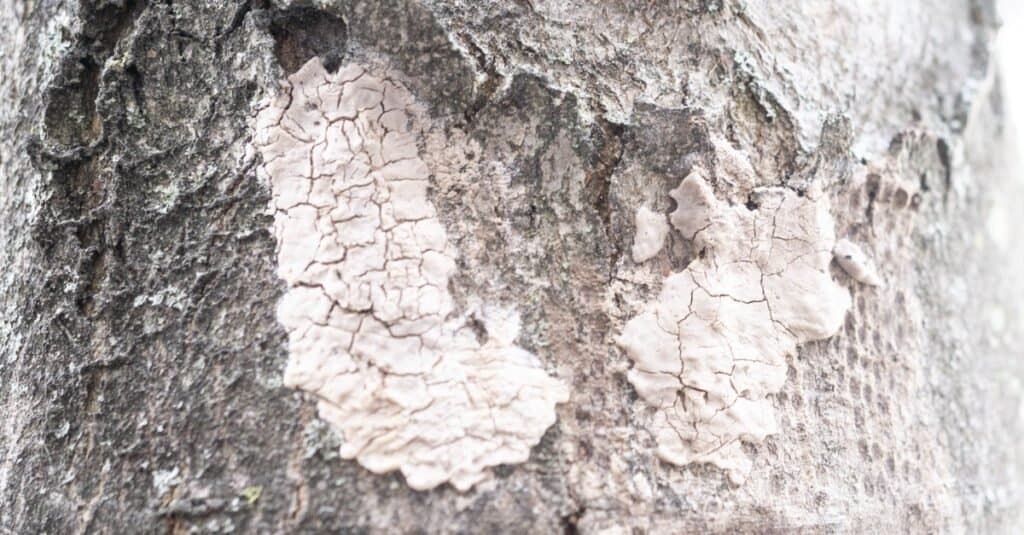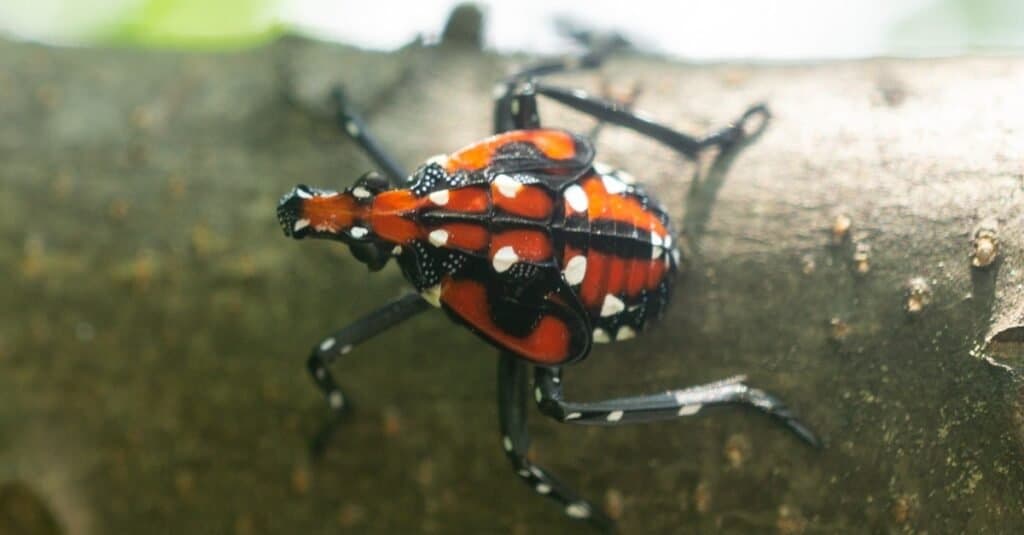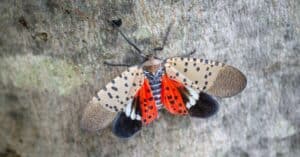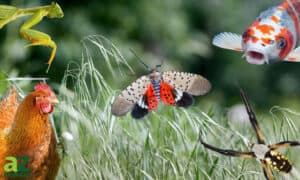Key Points:
- Spotted lanternflies are an invasive, plant-eating insect that has been introduced into several countries.
- Identifying and removing lanternfly eggs from where they are attached on leaves is one of the top ways to help eradicate the pest.
- Adult lanternflies are able to fly and jump far, meaning they are harder to get rid of.
The spotted lanternfly is a voracious plant-eating insect with an interesting and complex life cycle. The adult lanternfly can be identified by the two pairs of spotted wings, which enable it to travel large distances (though it actually jumps more than it flies). Due to its appearance, this insect is often mistaken for a moth. However, the name itself is a bit of a misnomer: it is not a fly at all (it’s more closely related to cicadas, leafhoppers, and aphids), and it has no glowing lantern-like parts. It actually belongs to a group of insects called the planthoppers.
The lanternfly was originally indigenous to parts of southern China, Taiwan, and Vietnam, but it has been since introduced into Japan, South Korea, and the United States, where it destroys native plants and causes some havoc. While its favorite plant host in its native habitat is the Chinese sumac or the tree of heaven, the lanternfly is known as a generalist. It likes to feed on the sap of more than 70 plant species, including cherry trees, apple trees, birch trees, maple trees, poplar trees, grapevines, and lilacs.
This species was first detected in the United States when it came to Berks County, Pennsylvania, just outside of Philadelphia, around the year 2014 (though its introduction may have dated all the way back to 2012). From there it spread rapidly to some parts of New York, Delaware, Virginia, New Jersey, and other states in the area.
Lanternflies pose a huge problem for various types of orchards and agriculture by damaging or sometimes even outright killing the plant. While they don’t necessarily eat the fruits and leaves, they do produce a sticky substance called honeydew as waste, which attracts all kinds of pests to the area and encourages mold growth. Unfortunately, there are few natural predators in the United States to stop their spread, thanks in part to their bad taste and toxin.
Because they’re considered to be an invasive species, state and federal governments have tried to restrict their spread. The Pennsylvania Department of Agriculture, for instance, recommends reporting signs of lanternfly activity as soon as possible before they can grow out of control. Many states encourage people to kill them on sight as well.
Egg Stage

©iStock.com/arlutz73
The adult lanternfly is easy enough to identify when you know what signs to look for. But the problem is it only spends a small portion of its life as an adult. The spotted lanternfly actually undergoes a complex transformation through several life stages. One whole generation takes about a year to complete. This process usually begins at some point between September and November.
After mating, the female lays large batches or rows of 20 to 60 eggs on smooth bark, fence posts, stones, furniture, or metal surfaces. In ideal conditions, a single tree can sometimes harbor up to 200 egg masses at a time. The female then covers the eggs in a white adhesive substance that becomes pink and gray as it begins to dry; this substance is often mistaken for mud or seed pods.
Instead of hatching immediately, however, the eggs will spend the entire winter in a state of suspended development, protected from the outside elements by the egg walls. They can survive exceptionally cold temperatures well below freezing before they die. The parents do not play any role whatsoever in caring for the young, but the eggs are camouflaged on the wood or metal surface to protect them against hungry predators.
Nymph Stages

©iStock.com/arlutz73
When the eggs finally hatch around May or June (around 60% to 90% of them will survive to this point), the spotted lanternfly will begin the first of four nymph life stages. An instar is a technical term for the life stages in between molts when the insect loses its skin and transitions into a new form. During the first instar, the spotted lanternfly measures about a quarter of an inch long; the shape of the insect leads many people to accidentally mistake it for some kind of tick, but the white spots covering the black body are an important clue to its identification.
This first nymph is already an excellent climber from the moment it hatches from the egg. If it falls from the tree due to some kind of strong wind or rough bark, then it can ascend all the way back up the trunk. Nymphs usually tolerate each other’s presence, but if too many nymphs are nearby, eating from the same food source, then one may challenge another to a fight by raising its forelimbs, in which case it will either flee or attempt to mount the challenger.
Both the second and third instars are fairly similar to the first in both appearance and behavior, except they become progressively larger in size with each new stage. By the end of the third molt, which takes place sometime between July and September, the fourth instar has grown a more distinctive appearance; it features a red upper body with white spots and black legs and markings. At this stage, it can measure up to three-quarters of an inch long.
Adult Stage

©iStock.com/arlutz73
An adult spotted lanternfly, which can emerge as early as July or as late as September, measures about an inch long. It is characterized by a black head and legs, a wide abdomen with yellow and brown stripes, and short orange antennae featuring needle-like tips. The females have an additional red tip at the end of the abdomen.
The easiest way to identify them, however, is the two pairs of wings. Featuring a pink or tan surface, these wings are adorned with black spots for about two-thirds of their length, followed by a striped or brick pattern near the end. When the insect is at rest, the wings are folded against the body; the upper wings mostly obscure the lower wings. When the insect is ready to jump or fly, it extends all four wings out so it almost resembles a moth.
Many people may try to dispose of adult spotted lanternflies, as they are easy to identify. Unfortunately, these guys can jump quickly and even fly away from any swat directed their way. While these critters are not harmless to humans, they are to plants, a good reason to want to get rid of them. The best way to go around this is by removing the eggs from plants they are attached to and soaking them in alcohol or put into a container to be tossed.
Dispersal and Mating
At some point after hatching, the spotted lanternfly will disperse from the place of its birth, usually traveling somewhere between 3 and 5 miles over its lifetime. Even the undeveloped nymphs have powerful hind legs to help them jump or climb, but the adults are particularly mobile, thanks to their large wings. They have a very strong habit of hitching a ride on vehicles by flying through windows or jumping into the back of a truck. Egg masses are also sometimes accidentally transported around, particularly on outdoor items like firewood, motor homes, or recreational vehicles. The spotted lanternfly will only spend a few months of its life as an adult.
The main purpose of the adult phase is to reproduce. Unfortunately, there is little information about the lanternfly’s mating behavior, other than the fact that it takes place at the same time every year in the autumn. It will only have a single opportunity to mate, because the adult lanternflies will die a short time later, allowing the next generation to thrive.
Up Next…
While lanternflies are quite beautiful insects, they are negatively impacting their non-native environments. Learn more on how to get rid of lanternflies and why invasive species are harmful.
- What Eats Spotted Lanternfly: Do They Have Predators? – If you’re curious as to natural predation of lanternflies, check out this article.
- How to Get Rid of Spotted Lanternflies – Whether you have seen lanternflies or are not familiar with them, learning how to get rid of this invasive species is beneficial to the environment.
- Why are Invasive Species Dangerous to the Environment? – Invasive species are usually plants or animals introduced to an area from another, but what makes them so detrimental?
The photo featured at the top of this post is ©
Thank you for reading! Have some feedback for us? Contact the AZ Animals editorial team.







